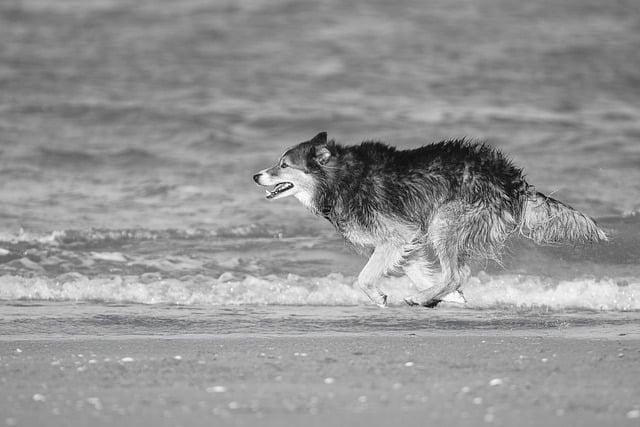One evening, Sarah noticed her dog, Max, trembling in the corner, a stark contrast to his usual playful self. Concerned, she recalled the recent thunderstorm that had rattled their home. Dogs, like Max, can be sensitive to changes in their environment—loud noises, unfamiliar scents, or even shifts in their owner’s mood can trigger anxiety. Understanding this, Sarah created a safe space for Max, filled with his favorite toys and soothing music. If your dog is acting weird or scared, it’s essential to investigate the cause and provide comfort. Your attention can make all the difference.
Contents
- Understanding Sudden Behavioral Changes in Dogs
- Identifying Potential Triggers for Fear and Anxiety
- Effective Strategies to Reassure and Comfort Your Dog
- When to Seek Professional Help for Your Pets Well-Being
- Q&A
Understanding Sudden Behavioral Changes in Dogs
When a dog suddenly exhibits strange or fearful behavior, it can be alarming for any pet owner. Understanding the underlying causes of these changes is crucial for addressing the issue effectively. Dogs are sensitive creatures, and their behavior can be influenced by a variety of factors, including environmental changes, health issues, and emotional stressors. Recognizing these triggers can help you provide the support your furry friend needs.
One common reason for sudden behavioral shifts is **environmental changes**. This could include moving to a new home, the arrival of a new family member, or even changes in routine. Dogs thrive on consistency, and disruptions can lead to anxiety and confusion. Pay attention to any recent changes in your household that might be affecting your dog’s sense of security. If you identify a trigger, consider creating a more stable environment by maintaining routines and providing a safe space for your dog to retreat to when feeling overwhelmed.
Health issues can also manifest as sudden behavioral changes. If your dog is in pain or discomfort, it may react by becoming withdrawn or fearful. Conditions such as arthritis, dental problems, or even internal illnesses can cause significant distress. It’s essential to consult with a veterinarian if you notice any unusual behavior, as early detection of health issues can lead to more effective treatment and a quicker return to normalcy for your pet.
Lastly, emotional stressors such as loud noises, changes in the household, or traumatic experiences can lead to fear-based behaviors. Dogs may react to fireworks, thunderstorms, or even the presence of unfamiliar people or animals. To help your dog cope, consider using **desensitization techniques** or providing calming aids such as anxiety wraps or pheromone diffusers. Creating a safe, quiet space where your dog can feel secure during stressful situations is vital for their emotional well-being.
Identifying Potential Triggers for Fear and Anxiety
Understanding the sudden changes in your dog’s behavior can be a perplexing experience. To effectively address these issues, it’s crucial to identify the potential triggers that may be causing your furry friend to feel fear and anxiety. Dogs are sensitive creatures, and their reactions can often be linked to specific stimuli in their environment. Observing your dog closely can provide valuable insights into what might be affecting them.
Common triggers that may lead to fear and anxiety in dogs include:
- Environmental Changes: A new home, rearranged furniture, or even a new family member can unsettle your dog.
- Loud Noises: Thunderstorms, fireworks, or construction sounds can create a sense of panic.
- Negative Experiences: A traumatic event, such as a visit to the vet or an encounter with an aggressive dog, can leave lasting impressions.
- Health Issues: Pain or discomfort from an underlying medical condition can manifest as anxiety or fear.
Additionally, social interactions play a significant role in your dog’s emotional well-being. If your dog has had a negative experience with another animal or person, they may become fearful in similar situations. It’s essential to monitor their interactions and provide positive reinforcement when they respond well to social cues. This can help rebuild their confidence and reduce anxiety over time.
Lastly, consider the impact of your own behavior on your dog’s emotional state. Dogs are incredibly perceptive and can pick up on their owner’s stress or anxiety. If you are feeling anxious or upset, your dog may mirror those feelings. Creating a calm and reassuring environment can help alleviate some of your dog’s fears. By addressing these potential triggers, you can work towards restoring your dog’s sense of security and happiness.
Effective Strategies to Reassure and Comfort Your Dog
When your dog exhibits sudden fear or anxiety, it’s essential to provide them with a sense of security and comfort. One effective approach is to create a safe space where your dog can retreat when feeling overwhelmed. This could be a cozy corner in your home, equipped with their favorite blanket and toys. **Encourage your dog to use this space** by offering treats or engaging them in playtime there. The familiarity of their safe zone can significantly reduce their anxiety levels.
Another strategy is to engage in calming activities together. **Consider incorporating gentle exercises** such as leash walks in quiet areas or low-impact games that don’t overstimulate your dog. Additionally, you might explore the benefits of canine massage or soothing music designed specifically for dogs. These activities not only help to distract your dog from their fears but also strengthen the bond between you, providing them with reassurance through your presence.
Consistency in your behavior is crucial when addressing your dog’s anxiety. **Maintain a calm demeanor** and avoid reacting negatively to their fearful behavior. Instead, use positive reinforcement to reward any signs of bravery or calmness. This could include verbal praise, treats, or extra playtime. By reinforcing positive behavior, you help your dog learn that they can trust their environment and that you are there to support them.
Lastly, consider the power of scent in comforting your dog. **Utilize calming pheromone diffusers or sprays** that mimic the natural scents that dogs find soothing. These products can create a more relaxed atmosphere in your home. Additionally, you might try introducing your dog to natural remedies, such as herbal supplements or anxiety wraps, after consulting with your veterinarian. These methods can provide extra layers of comfort and help your dog feel more secure during stressful times.
When to Seek Professional Help for Your Pets Well-Being
When your dog exhibits sudden changes in behavior, such as fearfulness or anxiety, it’s crucial to pay attention to these signs. While some fluctuations in mood are normal, persistent or severe changes can indicate underlying issues that require professional intervention. If your dog is displaying unusual behaviors, consider seeking help if you notice:
- Prolonged Fear or Anxiety: If your dog seems consistently scared, hides frequently, or shows signs of distress over an extended period, it’s time to consult a veterinarian or a certified animal behaviorist.
- Physical Symptoms: Accompanying physical signs such as trembling, excessive panting, or changes in appetite can signal that your pet is experiencing more than just a temporary phase.
- Destructive Behavior: If your dog begins to chew furniture, dig excessively, or engage in other destructive behaviors, this could be a cry for help and a sign of deeper emotional distress.
- Changes in Social Interaction: A sudden withdrawal from family members or other pets, or an increase in aggression, can indicate that your dog is struggling with anxiety or fear.
It’s essential to remember that behavioral changes can stem from various sources, including environmental stressors, health issues, or traumatic experiences. A professional can help identify the root cause and provide tailored strategies to address your dog’s needs. Early intervention can prevent the escalation of anxiety and help your pet regain their confidence and happiness.
Moreover, your veterinarian can rule out any medical conditions that may be contributing to your dog’s unusual behavior. Conditions such as pain, neurological disorders, or hormonal imbalances can manifest as fearfulness or anxiety. By ensuring your dog is physically healthy, you can focus on addressing any behavioral concerns without the worry of underlying health issues complicating the situation.
seeking professional help not only benefits your pet but also enhances your relationship with them. Understanding the reasons behind their behavior can foster a deeper bond and improve communication. With the right guidance, you can create a safe and supportive environment that allows your dog to thrive, ensuring their well-being and happiness for years to come.
Q&A
-
What could be causing my dog to act scared suddenly?
There are several potential reasons for your dog’s sudden change in behavior. These may include:
- Exposure to loud noises (thunder, fireworks, etc.)
- Changes in the environment (new home, new pets, etc.)
- Health issues or pain
- Traumatic experiences (accidents, abuse, etc.)
-
How can I tell if my dog is scared?
Signs of fear in dogs can vary, but common indicators include:
- Hiding or seeking shelter
- Excessive barking or whining
- Trembling or shaking
- Avoidance of eye contact or cowering
-
What should I do to help my scared dog?
To support your dog during this time, consider the following steps:
- Provide a safe and quiet space for them to retreat to.
- Use calming products such as pheromone diffusers or anxiety wraps.
- Engage in gentle play or distraction techniques.
- Consult a veterinarian or a professional dog trainer for further guidance.
-
When should I seek professional help for my dog’s behavior?
If your dog’s fear persists or worsens, it’s crucial to seek professional help. Signs that indicate the need for assistance include:
- Severe anxiety that disrupts daily life.
- Aggressive behavior towards people or other animals.
- Physical symptoms such as loss of appetite or excessive grooming.
understanding your dog’s sudden fear and unusual behavior is crucial for their well-being. By observing their environment and consulting a professional, you can help restore their confidence and strengthen your bond. Don’t hesitate to take action for your furry friend!




